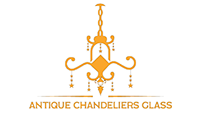
Glass and crystal
Glass chandeliers were made since the seventeenth century.
At the end of the seventeenth century the lead crystal was discovered.
Key difference: Glass is a generic name, while, crystal is a subcategory of glass, made in the same manner as glass but with different materials. Hence, all crystal is glass, but not all glass is crystal.

There are three primary criteria for crystal as established by the European Union in 1969: a lead content in excess of 24%, a density in excess of 2.90 and a reflective index of 1.545.
Scientifically, crystals are pure substances whose atoms, molecules, or ions are arranged in an ordered pattern, where they extend in all three spatial dimensions. Crystals most commonly occur naturally on the earth, though the process of crystal formation via mechanisms of crystal growth is called crystallization or solidification.
However, that is not the official difference between the two. Actually, there is no official clean cut definition of crystal. Still, the general rule that applies is that crystal is a type of glass that contains lead.
According to John Kennedy, head of technical services at Waterford in Waterford, Ireland, there are very specific guidelines for what constitutes real crystal. There are three primary criteria for crystal as established by the European Union in 1969: a lead content in excess of 24%, a density in excess of 2.90 and a reflective index of 1.545. However, outside of the European Union, this definition is usually disregarded. In the United States, any glass with more than 1% of lead content is termed as crystal.
Technically, the application of the term ‘crystal’ to glass is in itself inaccurate, as glass is an amorphous solid. Hence, by definition it lacks a crystalline structure, which is necessary for a crystal. Still, the term, even though erroneously applied to glass, has stuck around and remains popular.
Chandelier glass can be made from a variety of materials: silica, soda-ash, soda-lime, potash, zinc, lead, barium, and, more recently, titanium. Technically, only products with at least 24% of lead should be appropriately termed as "lead crystal", while products with less lead oxide or glass products with other metal oxides instead of lead oxide, should be termed as "crystallin" or "crystal glass". Still, these are all often popularly termed as crystal.
The color and brilliance of glass often varies, depending on its content. Glass made with iron tends to have a green tinge, while glass made with soda-lime will have an aqua tinge. While, some find these tinges to be unattractive, glasses with a greenish hue tend to be considerably stronger. Crystals generally are light in color and are mostly translucent. Some clear crystals have the properties of reflecting light into different colors. When held in the right position, the refraction and dispersion of light from crystal will create a rainbow of hues.
Glass and half crystal

Many of the twentieth century chandeliers are decorated with glass or half crystal drops. There are many differences in quality. The drops are pressed in a mold and later on cut by hand or machine. The quality of the glass, shape of the mold and the way of polishing the glass determine the final result. Nowadays a large number of modern chandeliers are made with Bohemian crystal, made in the Czech Republic.
